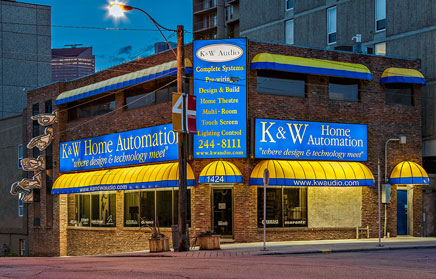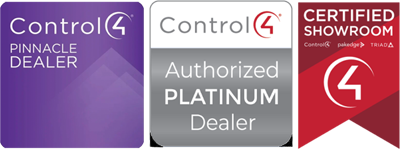Tip #45:
We are often asked for a rule of thumb or a specific formula. Over the years we have discovered our share of tweaks and tricks to use as “combination solutions”, each of which offer increased performance.
Room dimensions are important, especially when designing a new theatre. It makes sense to try to get the best room acoustics with the smoothest frequency response, by eliminating areas in the room that amplify or reduce the specific sounds produced by the system. We defer to our friend Mr. Lucas, or more precisely the “TH” in THX, Tomlinson Holman (X is for eXperiment). He say’s the best formula is 1 x 1.6 x 2.33. Taking into account that the 1″ will almost always be the ceiling height, we end up with a rectangle of relatively modest proportions. If you have a larger space to fill, other dimensions work well too, but this is the most popular formula.
Now it is a good idea to hook everything up correctly! Remember the three P’s, Phase, Polarity and Pink noise. Many good systems never perform at their best, simply because a single set of speaker cables were reversed. When this happens, the focus is lost, bass gets spacey and light, and the best recordings are most affected. Make sure that the positive and negative terminals on the amplifier connect with matching positive and negative terminals on the speakers. Be sure that the right and left inputs to the amplifier are actually connected to the right and left outputs of the source components. When setting up a surround processing system, the next step is the pink noise audio test. This test ensures that the amplifier is properly calibrated to its maximum performance capability. It is a very important step, but we find that many people just don’t do it. We don’t have the room here to review all the steps, but this one is quite simple and it is in our Tip archive (www.kwaudio.com/tips.html) at our web site. It is also explained in the amplifier’s instruction manual.
Correct speaker placement is a big one. If the speakers have been positioned for maximum décor integration the result is often a compromise. The tweak here is to forget the furniture and concentrate on the speakers. Arrange the furniture after the speakers have been placed for optimum performance. The stereo main fronts should be exactly the same distance from the wall behind them (use a tape measure) and that distance should be at least the same as the depth of the speaker cabinet (half as much again if possible). The distance to the sidewalls should be identical for each speaker with this dimension calculated in the same way BUT, the rear and side dimensions should not be divisible evenly by one another (i.e.; not 8 x 4, or 9×3, but 12 x 7, or 10 x 13). Place the listening position in the centre between the two main speakers, and back, from an imaginary line drawn across the front of the speakers, 1 to 1.5 times the distance between the speakers. Toe in the speaker cabinets so that the inside cabinet sides are just visible, equally on both sides, from the established listening position. Play a tune. Now figure out what to tell your spouse about the furniture layout!
Cables, spikes, and cones. These accessories all make a noticeable improvement to any system. While cables alone merit an entire thesis and white paper, we are here for the little tricks. So, digital hook up of that shiny new DVD player can be with either coaxial or fiber optic cable – they sound quite different. More high frequency balance and brighter with fiber, smoother and richer with coaxial. These characteristics can be used to tame a bright sounding system, or make up for an overly absorptive room. Spikes and cones do the same thing, spikes for speakers, cones for electronics. They will generally increase focus of the image and clean up the bass, offering greater articulation and extension. Make sure to level the spikes under the speakers, and place the spikes under the components so that the unit does not rock. Amazing gains.
Power bars, power flywheels, and power stabilizers may look much like a real high-end power bar – they are not. A high quality power center (a combination of power stabilizer and conditioner) will bring out the best in a DVD, CD, Satellite receiver etc. by providing isolated, garbage free and stable power to them. In addition it will isolate the amplifier’s big transformer, preventing talk-back through the power lines to other devices. Of course the obvious benefit is stopping the big power dip, and constant hash that happens when the fridge kicks in.
Groundbreakers are important now that most audio systems have cable TV, and increasingly so due to the presence of cable TV’s ground plane in the audio system. Groundbreakers can offer remarkable improvement, especially in picture and video display performance. Snow, lines at an angle moving behind the image and even annoying background hum from speakers can often be resolved with a 20 dollar ground breaker. This item is easily attached in the cable TV line ahead of all components.
One more trick rather than a tweak, if you will, is for small bookshelf speakers actually mounted on bookshelves. Place a cassette case or similar shaped piece of wood behind the speaker cabinet, with the long side towards the wall, then push the speaker back so that the case is wedged between the cabinet and the wall – bass response will improve. Try it!
The tricks we have talked about so far are safe and provide noticeable performance advantages. You can hear the difference right away. There is however a dark side to this area i.e. green marker applied around a CD, claimed to improve the sound of the CD, but later found to actually degrade the CD’s metal film over time. Fuse replacement with a solid core wire can offer a small improvement in power delivery and soundstage but the downside of having no fuse in the unit is obvious. Use of “Tweak” (a brand name) or Cramolin, which are WD-40 type products used on audio interconnects for “superior conductivity” can actually destroy the surface of some high quality connectors.
The biggest pitfall with tricks and secret formulas can be a lack of focus, not so much on the equipment, but by the user. Tweaks can become an endless cycle of trying to wring out of a system some performance component that simply is not there. The ultimate answer to a problem may be to buy a new component that does meet a certain performance criteria. Unfortunately there is no end-all fix, but it does give us satisfaction to know that we are getting all that we paid for. Don¹t stay up all night now!
Bang & Olufsen have released a new home theatre combination known as the Beosystem1. When combined with their all-new DVD player, this system offers an approach to the home theatre experience that only Bang and Olufsen can provide.
Fujitsu is the inventor of the plasma display, and the manufacturer of most plasma screens sold today, they also manufacture the panel for many other well-known brands. They have just introduced a stunning new 50″ flat plasma display. The 50″ is 3″ deep and weighs less than 100 lbs. As well as being a cool TV, it can function as a computer monitor, and provide incredible clarity and richness from other sources such as DVD, VCR, Camcorder etc. They say seeing is believing, when you see it you will believe!
Escient, the leader in cinvergence technology, introduced a couple of new music items showing the way of the future in music access and management. Their new Fireball has a hard drive capable of holding 700 hours of music. When music is stored on a hard drive the access time is near instant, no more waiting for that next CD to load. We can compile a play list that allows us to listen to our favorite tunes for weeks without ever hearing the same piece twice. It also finds new favorites by offering Internet radio capability, which is just so cool. But, the best part is control. Using an all- new graphical user interface (GUI) this system is so easy to use, and the possibilities for multi-room audio distribution and automation make this a renaissance item. You have to see it to appreciate how this item will revolutionize operation and access to any audio system.
Parasound blew everyone’s collective socks off at the 2001 CEDIA show, with the unveiling of an outstanding line of home theatre electronics, code named Halo. The line boasts two levels of surround processor/amplification and DVD combinations. Their number one system boasts a surround pre-amp with state-of-the- art processing, THX Ultra2 certification, RS-232 control, the highest quality components and a TFT video display screen nestled in the middle of the unit’s gorgeous silver faceplate. Couple all these features with a matching DVD player (with yet another TFT display for video preview), add a 1600 line-up converter, matched to high bias class A and A/B 5 channel amplifiers. We now have an all-singing, all- dancing system that asserts itself as the best, regardless of price.
An all-new product type has recently arrived, in the form of a Power Flywheel, by the Richard Gret Power Company. This is a very interesting item, which stores, stabilizes and conditions the power on an entire circuit. In this case, it does some remarkable things – increasing audio clarity and authority and dramatically increasing picture performance from the latest digital displays. Truly, a noticeable performance enhancer for all things electronic, achieved by feeding the components exactly what is needed, powerwise. It has been released to the press with nothing but rave reviews for this, a new product category.
One of our favorite speaker manufacturers is Totem, a fine Canadian company which has really come of age. It couldn’t happen to nicer people. At the top of the Totem pole is Vince Brusesse, whose vision and passion for music is matched by few. He has a genuine non-technical way of imparting his considerable knowledge to others in our industry. If you have ever wanted to meet this luminary of the audio world your chance has come. Vince will be dropping by the shop on November 15 for an informal chat, so make note and drop by to visit a real icon!
Speaking of icons, an old friend, Greg Krause, has recently joined our ranks. Greg has been part of the audio world for over two decades, and his depth of knowledge and helpful, honest attitude makes it great to have him on board. If you know Greg, or would like to meet him, drop by to say “Hi” and have a coffee with him.


